When Tony Calumet landed in Nome, Alaska in September 2020, he whispered a prayer: “If this is what you want, God, you’re going to have to help me.” At nearly 69 years old—an age at which one usually thinks of retiring—Calumet had just committed to five years of serving as general manager for KNOM, the nation’s oldest Catholic radio station located in one of the most remote areas of the country. Sight unseen.
After receiving numerous inner “promptings,” Calumet felt certain he was following a spiritual calling. But as KNOM’s news director drove him around the rustic town, his first thought was, “What did I get myself into?” The unpaved roads, meager homes, and extremely isolated surroundings bordering the Bering Sea reminded Calumet of a small Russian village.
Calumet had no experience with Alaska, Russia, or acclimation to sparse hours of daylight during the deepest winter months. But he believed in KNOM’s mission. He would soon understand the reason behind the radio station’s longevity and what made it exceptional in the eyes of both its mostly Alaska Native listeners and mostly out-of-state financial supporters.
“The more I got involved in the community and got to know people, the more my enthusiasm grew. I thought, ‘Wow, I’m here for a reason,’ ” Calumet says.
Despite having spent 35 years in radio, the last several with Iowa Catholic Radio, nothing prepared Calumet for KNOM’s vital and unique mission. Simply greeting people while walking down Front Street—one of Nome’s three paved roads—or shopping at Hanson’s Trading Co. for groceries triple in cost to what he was used to, Calumet was amazed that residents recognized his voice. “They’d stop and say, ‘Hey, I heard you on the radio this morning!’ ” he says. Humbled, Calumet began realizing the magnitude of the role that he and KNOM played in their lives.
This hit home even more when he traveled to outlying villages. From the Yukon Delta to the Bering Strait, KNOM’s coverage of approximately 100,000 square miles stretches deep into the Alaskan bush. Many of its listeners live so remotely that KNOM offers their only connection to the larger world. Every day across western Alaska, 20,000 listeners wake up to local news and music. They depend on the station for lifesaving information, national and international news, cultural and environmental concerns, and spiritual strength.
It’s no wonder that everywhere he visited, Calumet heard KNOM playing in the background. As he met with and listened to the Iñupiat, one of several Indigenous peoples in western Alaska, he began to understand the experiences of Alaska Natives. “Once you get people to trust you—and it takes time because of the way they’ve been treated in the past,” Calumet says, “and you have an ear to listen to their stories, you discover that it’s just horrific how they’ve been mistreated.”
It’s an enormous good that KNOM does by providing a platform for Indigenous culture, keeping languages alive, passing on knowledge from elders in the community, and celebrating the cultural practices.
Jennifer Van BoxelAdvertisement
From the negative effects of the early 1900s gold rush—when Nome’s population surpassed 20,000, bringing abuses from white settlers and missionaries alike—to the loss of the Inuit voice and ensuing enactment of Jim Crow laws, to the challenges to their traditional way of life while possessing no political clout, Alaska Natives have been marginalized for years.
For half a century, KNOM has sought to change that.
Amending the past isn’t possible, but, as Calumet has been discovering, KNOM’s role is much more than that of a radio station. Seeking to be a respectful companion, an unbiased resource for news, and a voice for those it serves brings with it a tremendous sense of responsibility for reporting accurately and fairly while staying true to Catholic ideals.
It’s this mission that impressed Calumet, a devoted Catholic, as it has many others who’ve also committed to supporting KNOM sight unseen.
“It’s an enormous good that KNOM does by providing a platform for Indigenous culture, keeping languages alive, passing on knowledge from elders in the community, and celebrating the cultural practices,” says Jennifer Van Boxel, a 20-year financial supporter who has never visited the 49th state. “The legacy of the past weighs on us all. KNOM can’t undo that, but it can help build a better future, where local cultures are elevated alongside the cross, not crushed in its shadow.”
Humble beginnings
When Tom Busch, a young broadcast engineer from the eastern United States, arrived in Nome in 1970 answering an ad to build a radio station, he had no idea that he’d be constructing it literally from the frozen ground up. After finding the land for a transmission tower, Busch used a giant chisel to dig through the permafrost.
He didn’t act alone. Joined by Natives and other volunteers, Busch dug 12 to 15 hours a day in the dark and subfreezing temperatures for several weeks. By the end of November, they’d erected the tower. Then came another big challenge—getting the paperwork squared away with the Federal Communications Commission and clearance from Canada and Russia.
Crafting a mission statement of “Encountering Christ, embracing culture, empowering growth, and engaging the listener,” KNOM finally aired on July 14, 1971, with Busch at the helm as general manager. When Jesuit Robert Whelan, the bishop of the Diocese of Fairbanks, pressed “play” to transmit the station’s first program across western Alaska, no one could have anticipated the immense effect this radio mission would have on its listeners or the national response to support it.
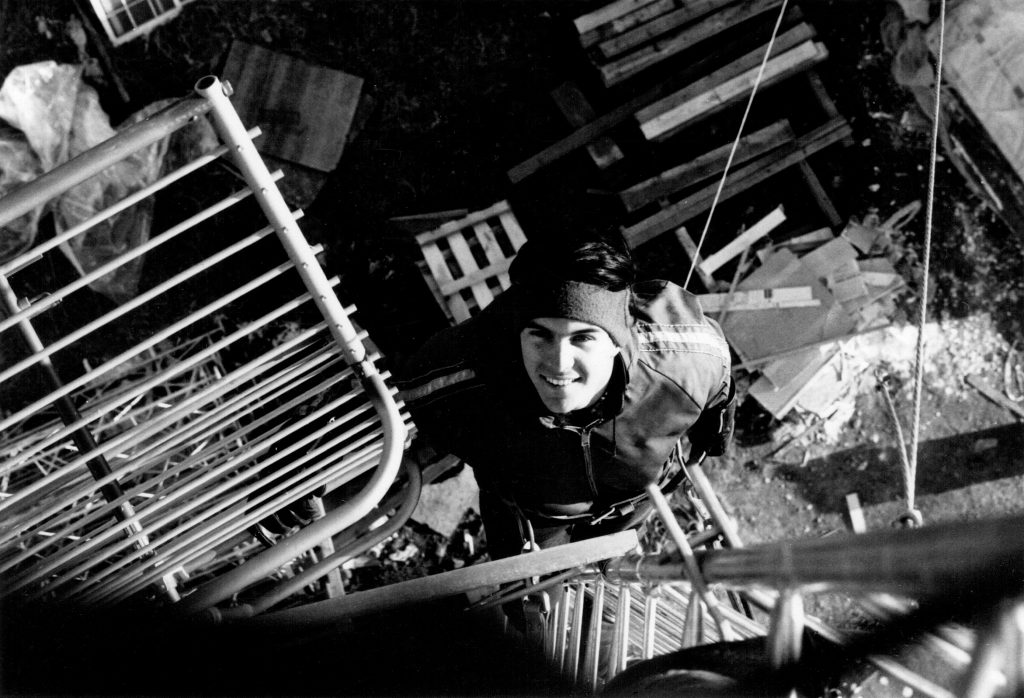
“All of the instrumental talents and initial funding to get established came from the lower 48,” says former general manager Ric Schmidt. He recalls the partnership KNOM formed with the Jesuit Volunteer Corps (JVC) in its early years to provide vital funding. Since recruitment was a big roadblock to staffing the Nome hospital in the 1970s and ’80s, KNOM used its JVC connection to get doctors and nurses on staff. These volunteers donated their entire hospital salaries to KNOM in exchange for housing at the station’s community complex.
When that arrangement ended, KNOM enticed college graduates to give a year of service. Nowadays, anywhere from three to five volunteers sign up every year to learn the ropes of broadcast journalism while serving in the Alaskan bush. In 1984 Schmidt was one of them. During that internship, he met his future wife, Lynette, and the couple returned to Nome eight years later with five children in tow. Schmidt worked under Busch as program director, and Lynette worked part time for the station while raising what eventually turned into six children. Schmidt followed Busch as general manager—the second of only four general managers in KNOM’s 50-year history. Combined, Busch and the Schmidts gave KNOM more than 85 years of their lives. And it’s still counting: Lynette retains a full-time position as business manager, which she’s held since 2005.
“That’s just remarkable to me,” says Calumet, who knows well the revolving door at many radio stations. The fact that people stay with KNOM so long is indicative of just how much they’re behind the mission. He’s seen it close-up in the commitment of both the staff and volunteers, many of whom stay on after their service year is up. He’s also seen it in the commitment of thousands of donors, some living as far as 4,000 miles away.
Surviving for 50 years is not easy for any nonprofit, but it’s even more challenging for a Catholic radio station in an area where most of its listeners can’t afford to support it. Unbelievably, as much as 99 percent of KNOM’s financial support comes from people living outside of Alaska—supporters who will never be able to tune in to the station. Yet even from afar Catholics understand the implications of keeping KNOM alive, and they gratefully support it.
Denise Stariwat of Spokane, Washington has been a KNOM donor for half its existence. Supporting marginalized people is what it means to “walk the talk” of being Catholic, she says. More importantly, “KNOM’s mission of both sharing the beauty of our Catholic faith and addressing social concerns is a perfect balance,” she says. “I love that Alaska Native elders are included in addressing concerns and seeking to come up with good answers. Jesus didn’t just share the good news. He also fed people, healed people, and cared so deeply about each person.”
KNOM’s mission of both sharing the beauty of our Catholic faith and addressing social concerns is a perfect balance.Denise Stariwat
Van Boxel agrees. “KNOM is a lifeline in a public service sense as well as a Catholic sense. Certainly Catholic messages, prayers, and Mass are part of its services but so are basic survival information, weather, general news, and all the wonderful cultural heritage of the local population,” she says. “I think Catholicism, while claiming to be universal, has often struggled with how to fit into the many corners of the world that exist. KNOM is an example of making this work. For me, supporting KNOM is the thing to do as a Catholic and as an American.”
Clearly, a national effort birthed KNOM. And national support enables it to continue to thrive half a century later.
Reporting with a Catholic lens
Calumet’s eye-opening education on the plight of Alaska Natives coincides with a greater reckoning on a national scale of societal injustices—sometimes subtle—against minorities and Indigenous peoples that, until recently, were often under the radar. While climate change and the melting of Arctic ice, economic justice, loss of food security, and the threat to sustainable living have gained wider national media coverage, these issues have long been part of the KNOM landscape.
With Nome’s population being nearly 65 percent Alaska Natives, such cultural concerns naturally rise to the forefront. What may be a notable difference with KNOM’s coverage is the objectivity and sensitivity reporters bring to their stories.
According to Ric Schmidt, who retired as general manager in 2017, it’s all in how the staff is trained. By living in a close community and traveling to remote villages, volunteers quickly absorb some of the Iñupiat culture and come to understand the life and death issues people face daily. Yet Schmidt believes that these young volunteers really don’t understand the enormity of what their work means to listeners. “If they did, they’d get so emotional that they wouldn’t be able to do their job,” he says.
For Calumet, maintaining objectivity filters well into the equation of a Catholic radio station.
When KNOM wanted to do an in-depth series on the years of sexual assault and disappearances of Native women—an issue also prevalent on reservations in the lower 48—Calumet met with staff members to discuss their intent. He knew the community needed to see this as a problem to be addressed and, at the same time, realized that having a spiritual perspective was important for reporters researching this story. Calumet wanted to ensure that KNOM covered the issue through a lens that showed both sides equally and thoughtfully and let listeners decide.
Although this is basic journalism 101, Calumet says, “Equal reporting on both sides of an issue is hard to find these days. If you’re only presenting one side, you’re going to be emotionally involved in it. In the investigative work we do, we’re not trying to convince people one way or another.”
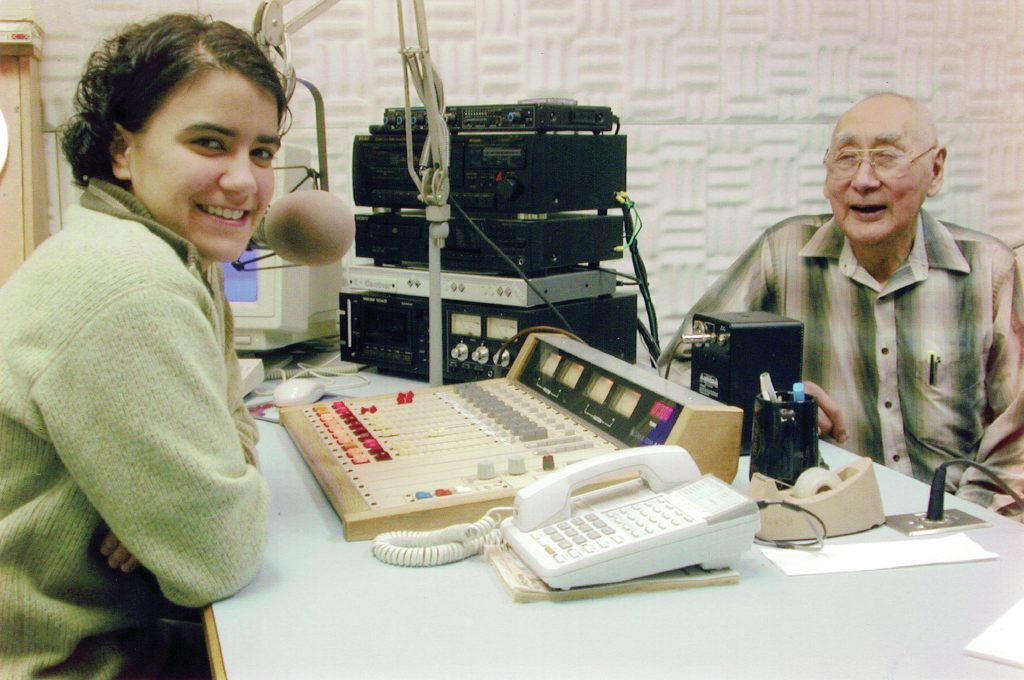
That’s been KNOM’s strategy from the beginning: Report exactly on what’s going on, do it with a sensitive and spiritual perspective, and don’t pose anything.
Sometimes that translates into covering mundane fish reports and brewing storms—essential information to listeners. “Folks could argue that’s not very spiritual,” Schmidt says. “Yet every single day we enhance and save lives. I’m sure Jesus would agree that food is absolutely integral to the whole celebration of the Mass. That’s what KNOM is all about. When you celebrate the culture and give information to help people do as well as they can to be able to feed themselves, you can imagine how important that becomes.”
But getting that information sometimes takes a lot of digging, knocking on politicians’ doors, and asking the tough questions. As Schmidt recalls from his early years with KNOM, forming bonds of trust was important for presenting both sides of an issue accurately. That meant going straight to the sources, so that the community knew what the federal and state governing bodies and politicians were saying.
That kind of unfiltered information is vital to educating KNOM’s listeners and preventing people in power from making decisions behind closed doors. Governmental restrictions and attacks on subsistence fishing and hunting rights could have detrimental effects on Alaska Natives’ livelihoods. In addition to broadcasting, KNOM gives the people a voice by organizing community meetings with governing bodies such as the Alaska Department of Fish and Game.
“Unlike national news that’s drummed up to form opinions, we’re not here to editorialize,” Schmidt says. “KNOM reports basic truths, and if we stopped doing that the listeners would be gone. People are starving for the truth, and they’ll naturally come if you’re offering it.”
It’s a practice that’s played out well with KNOM’s donors and listeners.
“KNOM’s articles are never accompanied by broad accusations,” says Van Boxel, who faithfully reads the monthly KNOM newsletter. “[KNOM staff] present what’s going on by talking to people who have experienced these issues, but without the vitriol. They’re reporters, not commentators.”
National appeal
Besides the long days of darkness and double-digit below zero temperatures, another big adjustment for Calumet was how KNOM raises money. At Iowa Catholic Radio, Calumet organized major local fundraising events at the Wells Fargo Arena in Des Moines, rubbed elbows with high-profile potential donors, and spoke at the Catholic Women’s Conference. No such opportunities exist in Nome.
Instead, communication with donors comes through long-distance personal phone calls and an informative newsletter that arrives in their email or mailbox every month. As business manager, Lynette Schmidt has taken time over the years to get to know the families and concerns of long-standing donors, send them sympathy cards, and personally sign every Christmas card. It’s no wonder donors feel like partners in the KNOM mission.
Through the newsletter, donors are connected to the lives of people they’ll never meet. Alaska Natives exude a pioneer spirit, which comes across through photographs of the culture at work and play as well as in the articles.
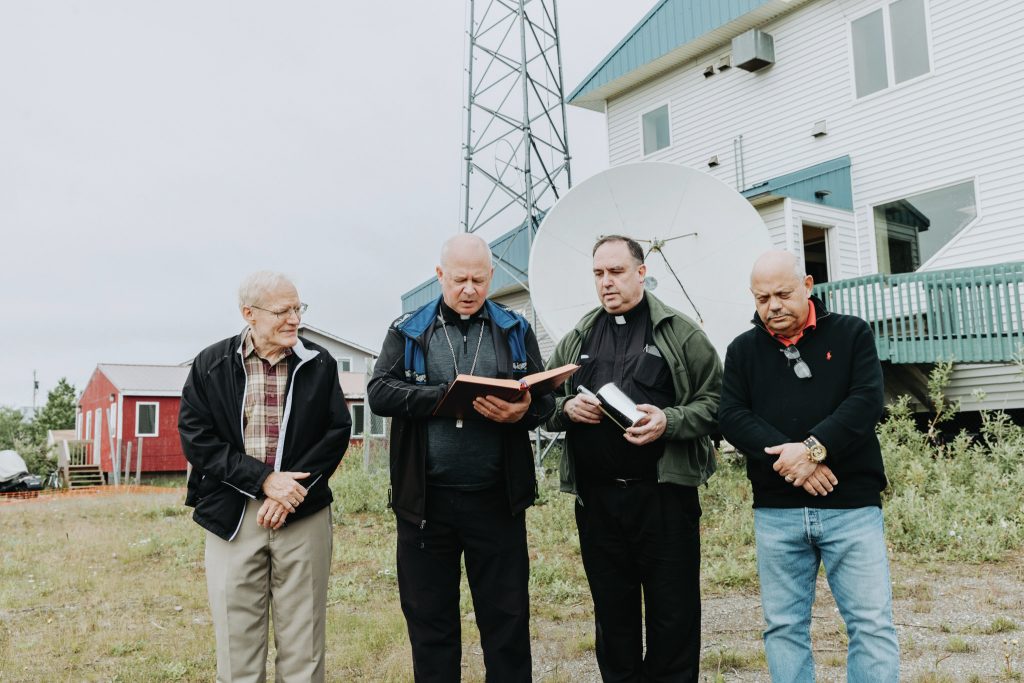
“The kind of loving nature exposed from village to village by the photos and the pioneer attitude that exists here is part and parcel of what was once common in the United States,” says Ric Schmidt. “But here you’re seeing people who continue to be part of the land. There’s something very grounded in all of that.”
That’s what appeals to donors like Stefan and Marianne Menger who, from their home in Pennsylvania, glimpse the challenges people face in Nome and the surrounding villages. Living in a densely populated area where parishes are plentiful and every need can be immediately gratified, the Mengers, like many Americans, find the isolation and life-threatening issues of the Alaskan tundra to be foreign to their reality. What KNOM does with their monthly donation both gratifies and impresses them.
“It’s a good combination of using money and rolling up their sleeves to join together to solve dilemmas,” Stefan Menger says. Like when the transmitter goes out or a 100-year storm knocks out all power and communication except for the lifeline of KNOM, running on a generator. “Without our dollars they wouldn’t be able to do this,” he says.
For Van Boxel, the pandemic and its accompanying isolation were other reminders of how such things are “business as usual for some far-flung communities.” She appreciates how KNOM gives her a broader viewpoint and window into a section of the world she wouldn’t have otherwise. “KNOM’s mission resonates with me because [KNOM] serves a population that it sometimes seems is living life in ‘hard mode’ all the time, but is able to do so with joy and grace, even though there’s pain and challenge,” she says.
As the Schmidts know, supporters must understand the cultural imperative if they’re going to donate regularly. Yet it still surprises them how much their donors get it.
Regardless of where people are coming from, KNOM is inclusive to everyone. That introduces them to the Catholic faith in a positive way.Stefan Menger
“In conversations we’ve had with folks, they sound so informed and understanding of what’s going on that you get the sense their insightfulness is off the charts,” says Ric Schmidt. “They absolutely get it. They also understand how listeners are being emotionally and spiritually fed, in terms of their worthiness and of being a citizen of the world and occupier of their own region. There’s an understanding that history has not been kind to Native peoples. Almost any minority or ethnicity in the United States has varying degrees of similar examples, from African Americans to Italian and Irish immigrants who experienced this in coming over. There’s an amazing understanding of the melting pot we are and how respectful we have to be of one another.”
It’s a key message that donors want to support—and even seem excited about—because it aligns with their Catholic faith. “Inclusivity is something KNOM does in the best sense of the word,” says Stefan Menger, who appreciates KNOM’s sense of community. “Regardless of where people are coming from, KNOM is inclusive to everyone. That introduces them to the Catholic faith in a positive way.”
The fact that KNOM brings such a positive message associated with Catholicism is no small factor in the mix of its 50-year success. Calumet knows he’s inherited quite a legacy, and he feels privileged to be part of it. Now that he has lived in Nome for more than a year, it easily feels like home. And more than that, he’s excited about the possibilities ahead and what he might accomplish during his tenure. “If we can bring somebody closer to Christ, and do that every day in this day and age, wow!” he says. “It’s something that could change lives. I think when it’s my time to finally retire, I’m going to walk away with one wonderful experience that I’ll always remember.”
This article also appears in the March 2022 issue of U.S. Catholic (Vol. 87, No. 3, pages 24-29). Click here to subscribe to the magazine.
Header Image: General manager Tony Calumet hosts the popular KNOM hotline.
All Images: Courtesy of KNOM


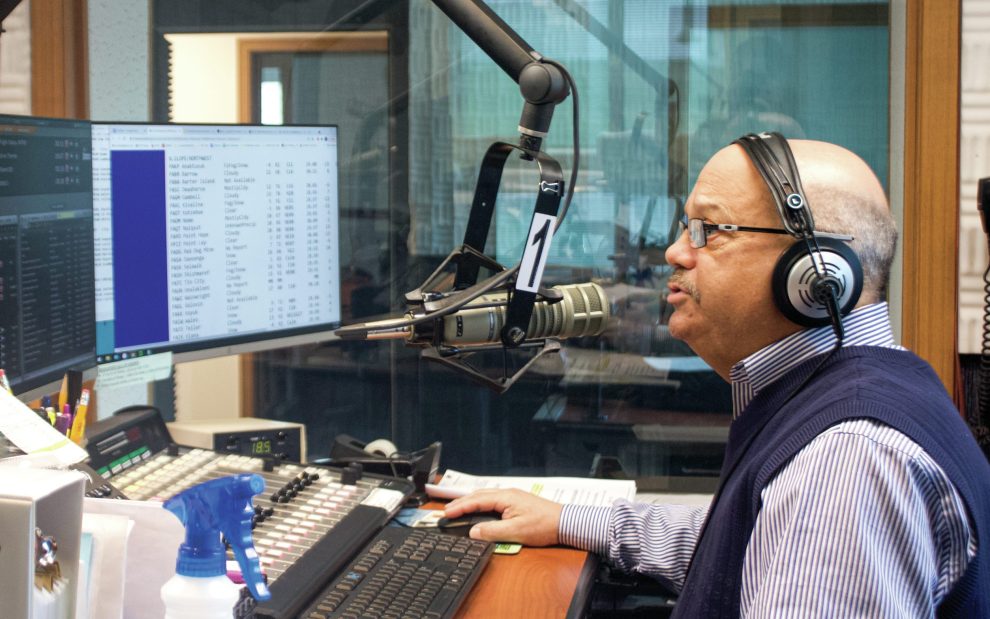



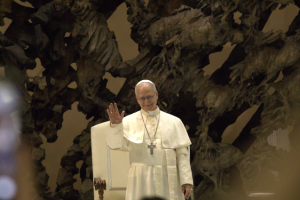






Add comment